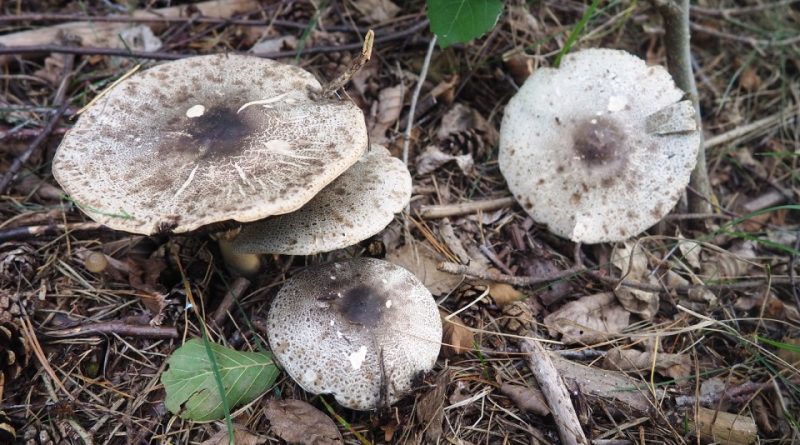Agaricus moelleri
Agaricus moelleri
The Inky Mushroom or dark scaled mushroom (Agaricus moelleri Wasser, 1976) is a fungus belonging to the Agaricaceae family.
Systematics –
From a systematic point of view it belongs to:
Eukaryota Domain,
Kingdom Fungi,
Basidiomycota Division,
Subdivision Agaricomycotina,
Agaricomycetes class,
Subclass Agaricomycetidae,
Order Agaricales,
Agaricaceae family,
Genus Agaricus,
A. moelleri species.
There are numerous synonyms, often due to the pileus coloration and arrangement of the scales, today all attributable to A. moelleri on the basis of molecular analysis:
– Agaricus lepiotoides;
– Agaricus meleagris (Jul.Schäff.) Imbach;
– Agaricus meleagris (Jul.Schäff.) Pilát;
– Agaricus meleagris var. obscuratus (Maire) Heinem.;
– Agaricus meleagris var. terricolor F.H.Møller;
– Agaricus moelleri var. terricolor (F.H.Møller) P.Roux & Guy García;
– Agaricus placomyces var. melagris (J.Schäffer) Moser;
– Agaricus placomyces var. meleagris (Jul.Schäff.) R.Pascual;
– Agaricus placomyces var. terricolor (F.H.Møller) Anon.;
– Agaricus placomyces var. terricolor (F.H.Møller) Moser;
– Agaricus placomyces var. terricolor F.H.Møller;
– Agaricus praeclaresquamosus A.E.Freeman;
– Agaricus praeclaresquamosus var. macrosporus Aparici & Mahiques;
– Agaricus praeclaresquamosus var. obscuratus (Maire) Quadr. & Lunghini;
– Agaricus praeclaresquamosus var. praeclaresquamosus A.E.Freeman;
– Agaricus praeclaresquamosus var. terricolor (F.H.Møller) Bon & Cappelli;
– Agaricus preclavesquamosus Freeman;
– Agaricus xanthoderma var. obscuratus Maire, 1911;
– Agaricus xanthodermus var. obscuratus Maire;
– Psalliota meleagris Jul.Schäff.;
– Psalliota meleagris var. obscurata (Maire) F.H.Møller;
– Psalliota meleagris var. terricolor F.H.Møller;
– Psalliota xanthoderma subsp. meleagris (J.Schäffer) J.Schäffer;
– Psalliota xanthoderma var. obscurata (Maire) A.Pearson;
– Psalliota xanthoderma var. terricolor F.H.Moller.
Etymology –
The term Agaricus comes from the Greek αγαρικόν agaricón agaric, (mushroom) of the Agari, because according to the Greek physician, pharmacist and botanist Dioscorides he came from Agarìa, a country of the Sarmatians.
The specific moelleri epithet should be in honor of the Swiss botanist Heinrich Möller (or Moeller 1882-1945), brother of Arturo F. Moeller (fl.1922-1931).
Geographic Distribution and Habitat –
Agaricus moelleri is a fungus that grows in the temperate areas of the northern hemisphere. It is present in North America, Asia, Great Britain and Europe.
Its habitat is that of mixed forests and woods where it is widespread, but it can be locally rare, in the period between summer and autumn.
Recognition –
Agaricus moelleri is recognized for having a hat of 5-15 cm, hemispherical then trapezoidal and finally flat convex, introflexed margin. The cuticle is dry, sooty black disc, dissociated into dark brown fibrils or scales on a white background, with undissociated disc. When pressed, it turns brownish.
The gills are dense and free, whitish for a long time, then slowly pink, finally blackish brown. Not smooth cut, finely dotted with black.
The stem measures 6-12 x 1-1.4 cm, almost uniform cylindrical, often curved, with a marginated basal bulb, naked and smooth, hollow, white with a silky sheen, finely striated, brown when pressed. Ring: large, broad and membranous, white.
The flesh is tender, white, chrome yellow when cut and when handled, in particular at the base of the stem, sometimes fleeting, then browning. Odor: unpleasant of phenol or ink, accentuated by cutting or rubbing especially at the base of the stem.
Under the microscope, dark brown spores are observed in mass, ellipsoidal, 4-6 x 3-4 µm. Tetrasporic basidia. Thin-walled, hyaline, piriform cheilocystidia.
Cultivation –
Agaricus moelleri is a fungus of some kind for cultivation due to its toxicity.
Customs and Traditions –
Agaricus moelleri is a basidiomycete fungus that can be found both under conifers and broad-leaved trees with a certain predilection for the latter.
It is one of the Agaricus with a yellowing base and a smell of phenol, therefore it is poisonous, its ingestion causes, in fact, a more or less pronounced gastrointestinal syndrome.
Among the similar species are mentioned:
– Agaricus praeclaresquamosus Freeman var. terricolor (Möller) Bon et Cappelli would differ from the type species for the coloration of the cuticle, darker, almost blackish, which, although dissociating, allows the underlying white between the scales to be seen with more difficulty; a 2005 study (Kerrigan, R.W. & al.) conducted also taking into account the DNA evidence showed that the aforementioned variety has no taxonomic value.
– Agaricus placomyces Peck, reported in America, has very similar macroscopic and microscopic characteristics, so much so that some authors consider them synonyms.
– It could also be confused with Agaricus phaeolepidotus (Möller) Möller, poisonous, with a more brownish pile color, decidedly brown and much coarser scales on the lower face of the ring, basal yellowing and a much less evident smell of phenol.
However, this mushroom can be easily recognized by the combination of its peculiar characters: scaled pileic surface, bulbous stem base and yellowing at the section, unpleasant smell of phenol or ink. The blackish scales of the hat, in contrast with the light color of the background, almost look like the dots of the plumage of a guinea fowl.
Furthermore, the typical smell of phenol, i.e. ink, at low temperatures can be hardly perceptible. In this case it is suggested to hold in your hands, and then heat, the piece of mushroom to enhance the smell.
Preparation Method –
Agaricus moelleri is a toxic fungus, which creates gastrointestinal syndrome more or less accentuated also according to the individuals and, therefore, it is not recommended, also for ecological reasons, to collect it.
Guido Bissanti
Sources
– Acta Plantarum – Flora of the Italian Regions.
– Wikipedia, the free encyclopedia.
– GBIF, the Global Biodiversity Information Facility.
– Useful Tropical Plants Database.
– Conti F., Abbate G., Alessandrini A., Blasi C. (ed.), 2005. An annotated checklist of the Italian vascular flora, Palombi Editore.
– Pignatti S., 1982. Flora of Italy, Edagricole, Bologna.
– Treben M., 2000. Health from the Lord’s Pharmacy, Advice and experiences with medicinal herbs, Ennsthaler Editore.
Photo source:
– https://www.artportalen.se/MediaLibrary/2021/8/48948876-b7f4-45fb-825a-02100a25cd74_image.jpghttps://www.artportalen.se/MediaLibrary/2021/8/48948876-b7f4-45fb-825a-02100a25cd74_image.jpg
– https://www.illustratedwildlife.com/illustrations/index.php?image_id=1644&category_id=10
Warning: Pharmaceutical applications and alimurgical uses are indicated for informational purposes only, they do not represent in any way a medical prescription; therefore no responsibility is taken for their use for curative, aesthetic or food purposes.


